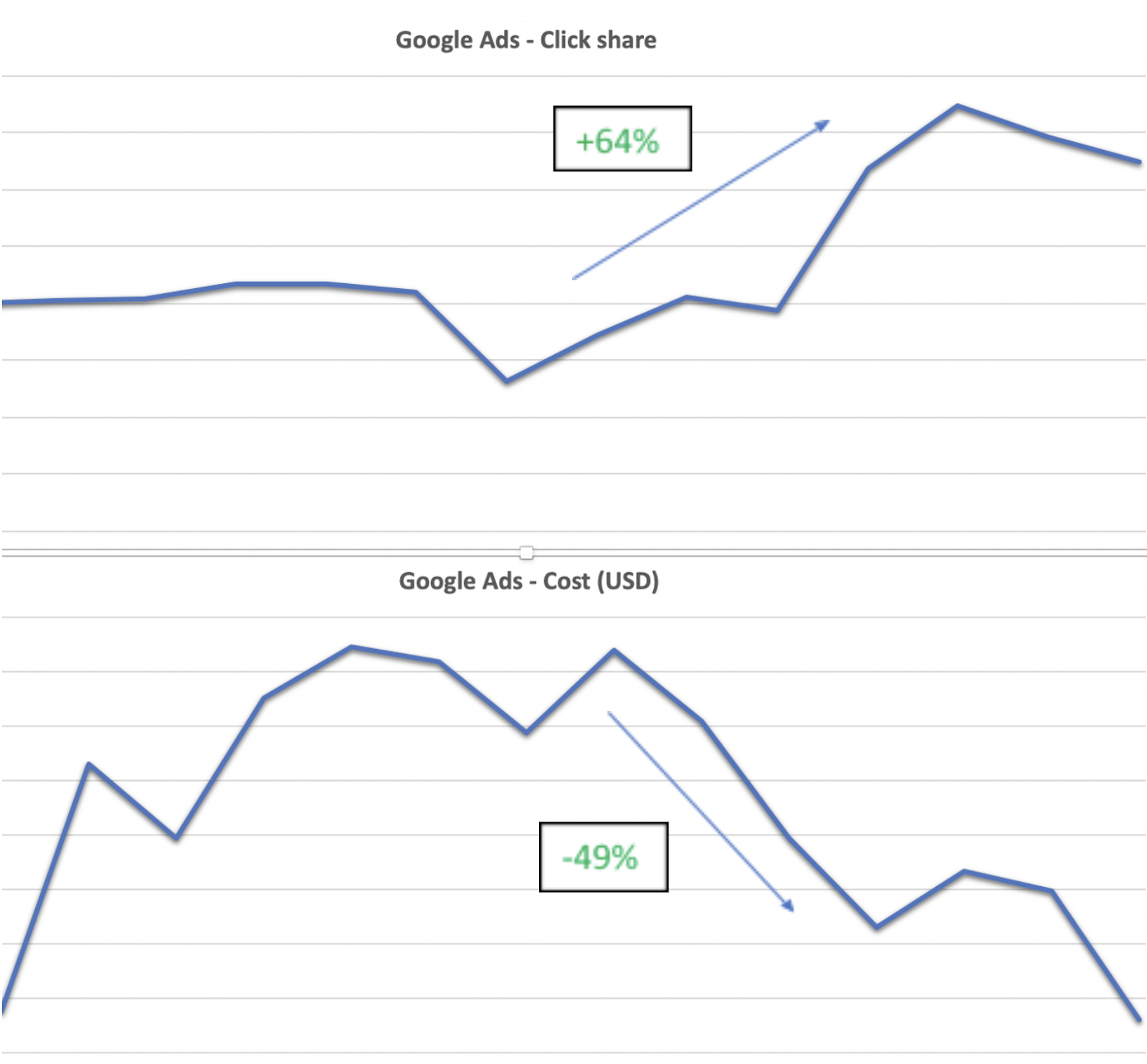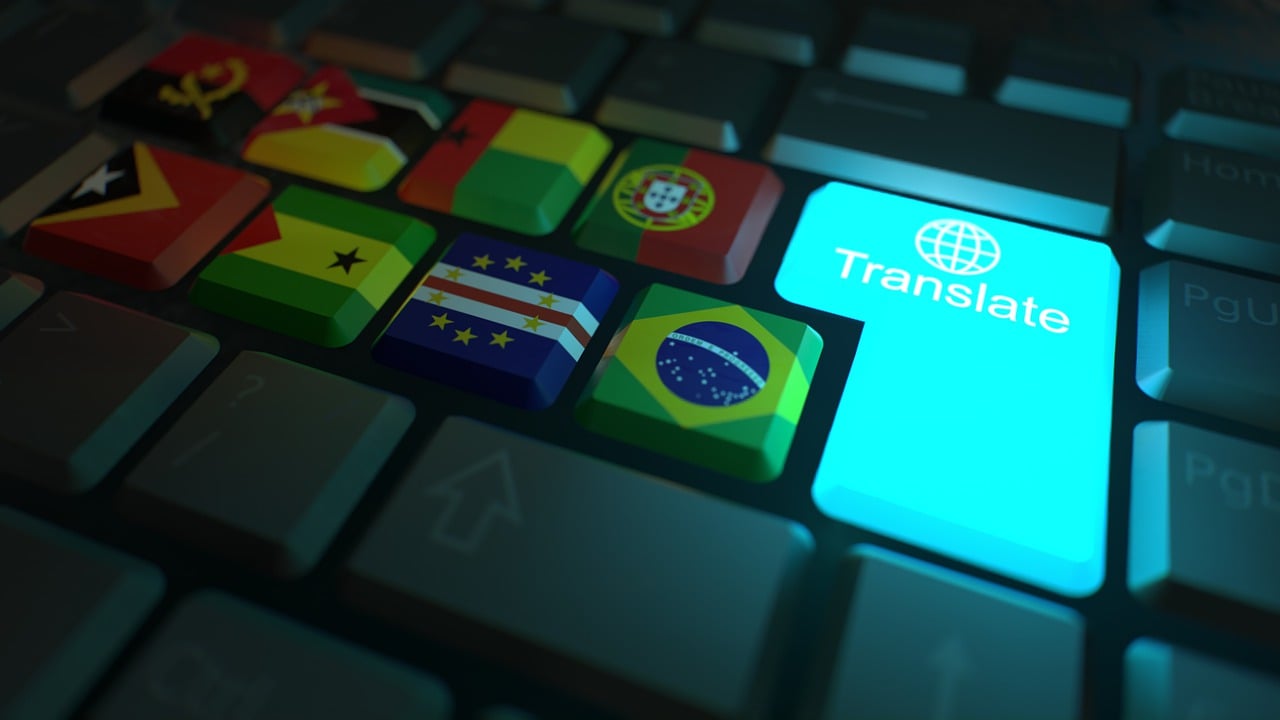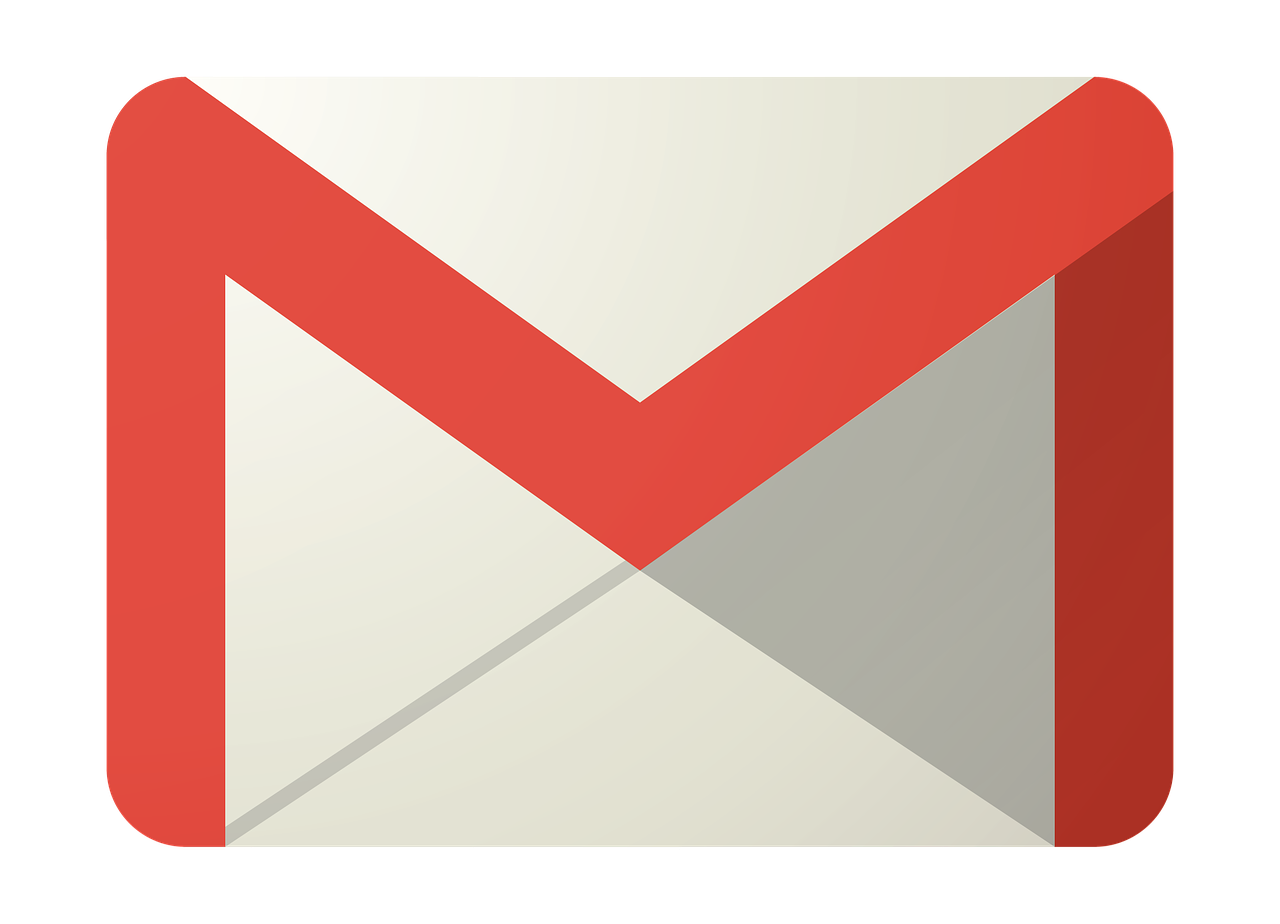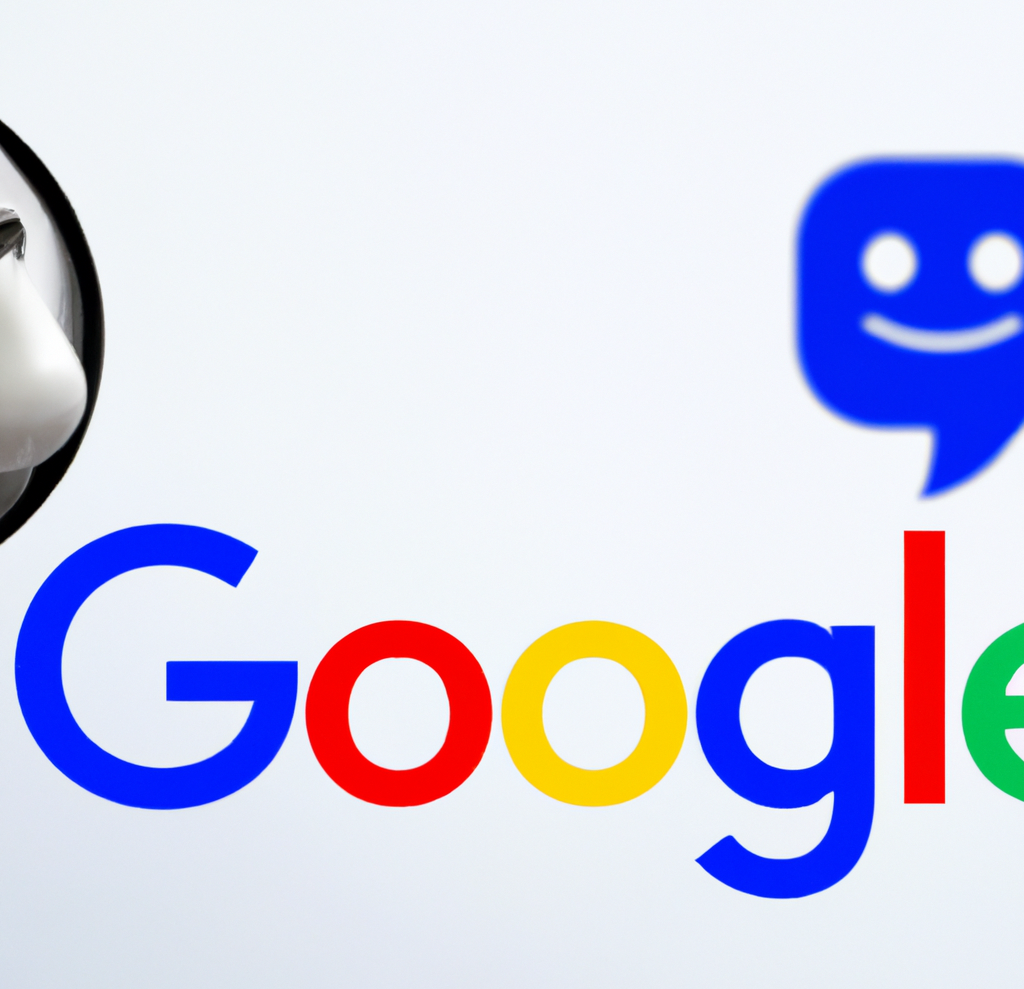Click Share Vs Impression Share – Which One Should You Care About?

The more aggressive your bids are, the more impression share you own, the more conversions you get. Simple, right? Well, not quite… Let’s start by breaking down what the famous share metrics actually mean!
Metric Definitions
Here is how Google define these terms:
- Search Impression Share: Impressions you’ve received on the Search Network divided by the estimated number of impressions you were eligible to receive.
- Impression Share (Top%): percent of your impressions that are shown anywhere above the organic search results
- Click Share: Number of clicks you’ve received on the Search Network divided by the estimated maximum number of clicks that you could have received.
Is it really all about showing on top of the Search Results?
It is hard to deny the impact of standing at one of the top spots on the Google search results. The platform boasts an incredible volume of highly qualified, action-ready customers. This consideration has led to continuous bidding wars as advertisers compete for traffic from their top valued keywords. In this aggressive battle, it can be easy to forget why digital advertising was a revolution: It’s all about targeting, who we show our ads to, and not how many people see it.
Impression share shows how often an ad appears, while click share demonstrates the frequency in which it is clicked. At the end of the day, quality website traffic is what we are after.
Following this philosophy, the plan on one of my accounts has been to create campaigns based on demographics. Each age group and gender was given its own campaign. For example, 64+ females and 18-24 males would both get their own separate campaigns. The result can be seen in the graph below: our advertising cost was cut by a half and our ads garnered more click share.
How is it possible that simply building campaigns around demographics can lead to a 49% decrease cost and a 64% increase in click share all at once. You would think that in a very competitive space, only bidding higher to maximize impression share can lead to a higher click share. In this instance, the exact opposite happened. To explain this rather counterintuitive result, let’s rephrase this blog title in a slightly different way.
Click share vs Impression Share, which one does Google care about?
Google’s number one goal is always going to be revenue. To do so, they will seek to provide users with the most useful, relevant query possible to maximize the chance of a paid click.
The giant’s triumph resides in his ability to successfully match the user intent to specific web pages. Therefore, the success of an advertiser on Google search ultimately depends on their ability to match their ads to the user intent. While keywords are powerful tools for targeting intents, they are only a first step.
Google provides us with countless information about the user that helps us evaluate with more precision what the intent behind a query can be and yellow Ferraris can help us understand how big of a difference this audience information can make.
The Yellow Ferraris (cause really I like them, and I know you do too…)
What is the difference between a 21-year-old, recent graduate, searching “Yellow Ferrari prices” and a 50-year-old, restaurant owner, searching “Yellow Ferrari prices”? The former is probably debating the topic with his friends in a restaurant, while the restaurant owner is actually trying to buy one. Same query, two different intents.
Going beyond keywords and looking at the audience behind the query allows advertisers to better match user intents and ride along Google’s boat, which, guess what, kind of seduces Google. If you are advertising yellow Ferraris, Google will favor you if you only show to high-income earners and could severely penalize you for bothering college students who simply do not care about buying such an expensive car at the moment.
By literally buying impression share, you are moving into irrelevant audiences. By going after click share, you are maximizing on your best audiences. Someone wants a Ferrari, you sell a Ferrari, deal! The user is happy, you are happy, and Google is happy and gives you the top spot you were craving for.
Yes, Google Rewards Effective Advertisers!
When ads are relevant, they get a better click-through rate, which then leads to a higher click share signaling Google that you are doing something right. Only in this situation will Google give you the top spot you deserve. The graph below shows the relationship between click-share, (top) impression share, and click-through rate during the same period of time for the client mentioned earlier.
It can clearly be observed that our impression share skyrocketed. So the final line is: it is not about showing as often as possible, it is about showing to the right person, as often as possible.
Instead of thinking about being on top of the page, we can think about serving the right user, which can be measured with our click share, and then Google will put us on top of the page, which we can see through our top impression share.
This can be done by leveraging all the user data available in Google such as detailed demographics, locations, affinity audiences, in-market audiences and more.
Our PPC Genius, Connor Regan, wrote a blog post that extensively touches on What Google audiences are and how they are determined. In the example mentioned above, the client campaigns were segmented based on demographics targeting: each campaign targeted a dedicated age group and gender. You might find better results segmenting your campaigns by locations for example.
At this point, you probably know to a good extent who your target audience is, so the ball is in your court. Think “relevance”, think “click share” first, and the rest will be given to you. Good luck!
AI
Exploring the Evolution of Language Translation: A Comparative Analysis of AI Chatbots and Google Translate

According to an article on PCMag, while Google Translate makes translating sentences into over 100 languages easy, regular users acknowledge that there’s still room for improvement.
In theory, large language models (LLMs) such as ChatGPT are expected to bring about a new era in language translation. These models consume vast amounts of text-based training data and real-time feedback from users worldwide, enabling them to quickly learn to generate coherent, human-like sentences in a wide range of languages.
However, despite the anticipation that ChatGPT would revolutionize translation, previous experiences have shown that such expectations are often inaccurate, posing challenges for translation accuracy. To put these claims to the test, PCMag conducted a blind test, asking fluent speakers of eight non-English languages to evaluate the translation results from various AI services.
The test compared ChatGPT (both the free and paid versions) to Google Translate, as well as to other competing chatbots such as Microsoft Copilot and Google Gemini. The evaluation involved comparing the translation quality for two test paragraphs across different languages, including Polish, French, Korean, Spanish, Arabic, Tagalog, and Amharic.
In the first test conducted in June 2023, participants consistently favored AI chatbots over Google Translate. ChatGPT, Google Bard (now Gemini), and Microsoft Bing outperformed Google Translate, with ChatGPT receiving the highest praise. ChatGPT demonstrated superior performance in converting colloquialisms, while Google Translate often provided literal translations that lacked cultural nuance.
For instance, ChatGPT accurately translated colloquial expressions like “blow off steam,” whereas Google Translate produced more literal translations that failed to resonate across cultures. Participants appreciated ChatGPT’s ability to maintain consistent levels of formality and its consideration of gender options in translations.
The success of AI chatbots like ChatGPT can be attributed to reinforcement learning with human feedback (RLHF), which allows these models to learn from human preferences and produce culturally appropriate translations, particularly for non-native speakers. However, it’s essential to note that while AI chatbots outperformed Google Translate, they still had limitations and occasional inaccuracies.
In a subsequent test, PCMag evaluated different versions of ChatGPT, including the free and paid versions, as well as language-specific AI agents from OpenAI’s GPTStore. The paid version of ChatGPT, known as ChatGPT Plus, consistently delivered the best translations across various languages. However, Google Translate also showed improvement, performing surprisingly well compared to previous tests.
Overall, while ChatGPT Plus emerged as the preferred choice for translation, Google Translate demonstrated notable improvement, challenging the notion that AI chatbots are always superior to traditional translation tools.
Source: https://www.pcmag.com/articles/google-translate-vs-chatgpt-which-is-the-best-language-translator
Google Implements Stricter Guidelines for Mass Email Senders to Gmail Users

Beginning in April, Gmail senders bombarding users with unwanted mass emails will encounter a surge in message rejections unless they comply with the freshly minted Gmail email sender protocols, Google cautions.
Fresh Guidelines for Dispatching Mass Emails to Gmail Inboxes In an elucidative piece featured on Forbes, it was highlighted that novel regulations are being ushered in to shield Gmail users from the deluge of unsolicited mass emails. Initially, there were reports surfacing about certain marketers receiving error notifications pertaining to messages dispatched to Gmail accounts. Nonetheless, a Google representative clarified that these specific errors, denoted as 550-5.7.56, weren’t novel but rather stemmed from existing authentication prerequisites.
Moreover, Google has verified that commencing from April, they will initiate “the rejection of a portion of non-compliant email traffic, progressively escalating the rejection rate over time.” Google elaborates that, for instance, if 75% of the traffic adheres to the new email sender authentication criteria, then a portion of the remaining non-conforming 25% will face rejection. The exact proportion remains undisclosed. Google does assert that the implementation of the new regulations will be executed in a “step-by-step fashion.”
This cautious and methodical strategy seems to have already kicked off, with transient errors affecting a “fraction of their non-compliant email traffic” coming into play this month. Additionally, Google stipulates that bulk senders will be granted until June 1 to integrate “one-click unsubscribe” in all commercial or promotional correspondence.
Exclusively Personal Gmail Accounts Subject to Rejection These alterations exclusively affect bulk emails dispatched to personal Gmail accounts. Entities sending out mass emails, specifically those transmitting a minimum of 5,000 messages daily to Gmail accounts, will be mandated to authenticate outgoing emails and “refrain from dispatching unsolicited emails.” The 5,000 message threshold is tabulated based on emails transmitted from the same principal domain, irrespective of the employment of subdomains. Once the threshold is met, the domain is categorized as a permanent bulk sender.
These guidelines do not extend to communications directed at Google Workspace accounts, although all senders, including those utilizing Google Workspace, are required to adhere to the updated criteria.
Augmented Security and Enhanced Oversight for Gmail Users A Google spokesperson emphasized that these requisites are being rolled out to “fortify sender-side security and augment user control over inbox contents even further.” For the recipient, this translates to heightened trust in the authenticity of the email sender, thus mitigating the risk of falling prey to phishing attempts, a tactic frequently exploited by malevolent entities capitalizing on authentication vulnerabilities. “If anything,” the spokesperson concludes, “meeting these stipulations should facilitate senders in reaching their intended recipients more efficiently, with reduced risks of spoofing and hijacking by malicious actors.”
Google’s Next-Gen AI Chatbot, Gemini, Faces Delays: What to Expect When It Finally Launches

In an unexpected turn of events, Google has chosen to postpone the much-anticipated debut of its revolutionary generative AI model, Gemini. Initially poised to make waves this week, the unveiling has now been rescheduled for early next year, specifically in January.
Gemini is set to redefine the landscape of conversational AI, representing Google’s most potent endeavor in this domain to date. Positioned as a multimodal AI chatbot, Gemini boasts the capability to process diverse data types. This includes a unique proficiency in comprehending and generating text, images, and various content formats, even going so far as to create an entire website based on a combination of sketches and written descriptions.
Originally, Google had planned an elaborate series of launch events spanning California, New York, and Washington. Regrettably, these events have been canceled due to concerns about Gemini’s responsiveness to non-English prompts. According to anonymous sources cited by The Information, Google’s Chief Executive, Sundar Pichai, personally decided to postpone the launch, acknowledging the importance of global support as a key feature of Gemini’s capabilities.
Gemini is expected to surpass the renowned ChatGPT, powered by OpenAI’s GPT-4 model, and preliminary private tests have shown promising results. Fueled by significantly enhanced computing power, Gemini has outperformed GPT-4, particularly in FLOPS (Floating Point Operations Per Second), owing to its access to a multitude of high-end AI accelerators through the Google Cloud platform.
SemiAnalysis, a research firm affiliated with Substack Inc., expressed in an August blog post that Gemini appears poised to “blow OpenAI’s model out of the water.” The extensive compute power at Google’s disposal has evidently contributed to Gemini’s superior performance.
Google’s Vice President and Manager of Bard and Google Assistant, Sissie Hsiao, offered insights into Gemini’s capabilities, citing examples like generating novel images in response to specific requests, such as illustrating the steps to ice a three-layer cake.
While Google’s current generative AI offering, Bard, has showcased noteworthy accomplishments, it has struggled to achieve the same level of consumer awareness as ChatGPT. Gemini, with its unparalleled capabilities, is expected to be a game-changer, demonstrating impressive multimodal functionalities never seen before.
During the initial announcement at Google’s I/O developer conference in May, the company emphasized Gemini’s multimodal prowess and its developer-friendly nature. An application programming interface (API) is under development, allowing developers to seamlessly integrate Gemini into third-party applications.
As the world awaits the delayed unveiling of Gemini, the stakes are high, with Google aiming to revolutionize the AI landscape and solidify its position as a leader in generative artificial intelligence. The postponed launch only adds to the anticipation surrounding Gemini’s eventual debut in the coming year.
-

 PPC4 days ago
PPC4 days ago19 Best SEO Tools in 2024 (For Every Use Case)
-

 MARKETING7 days ago
MARKETING7 days agoWill Google Buy HubSpot? | Content Marketing Institute
-
SEARCHENGINES7 days ago
Daily Search Forum Recap: April 16, 2024
-

 SEO6 days ago
SEO6 days agoGoogle Clarifies Vacation Rental Structured Data
-

 MARKETING6 days ago
MARKETING6 days agoStreamlining Processes for Increased Efficiency and Results
-
SEARCHENGINES5 days ago
Daily Search Forum Recap: April 17, 2024
-

 PPC7 days ago
PPC7 days agoHow to Collect & Use Customer Data the Right (& Ethical) Way
-

 SEO6 days ago
SEO6 days agoAn In-Depth Guide And Best Practices For Mobile SEO





